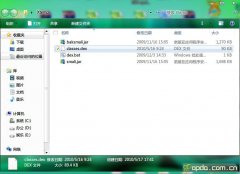android 资源文件的使用说明
android 从assets和res中读取文件(转)
1. 相关文件夹介绍
|
目录Directory |
资源类型Resource Types |
|
res/anim/ |
XML文件,它们被编译进逐帧动画(frame by frame animation)或补间动画(tweened animation)对象 |
|
res/drawable/ |
.png、.9.png、.jpg文件,它们被编译进以下的Drawable资源子类型中: 要获得这种类型的一个资源,可以使用Resource.getDrawable(id) 位图文件 9-patches(可变尺寸的位图) 为了获取资源类型,使用mContext.getResources().getDrawable(R.drawable.imageId)
注意:放在这里的图像资源可能会被aapt工具自动地进行无损压缩优化。比如,一个真彩色但并不需要256色的PNG可能会被转换为一个带调色板的8位PNG。这使得同等质量的图片占用更少的资源。所以我们得意识到这些放在该目录下的二进制图像在生成时可能会发生变化。如果你想读取一个图像位流并转换成一个位图(bitmap),请把图像文件放在 res/raw/目录下,这样可以避免被自动优化。 |
|
res/layout/ |
被编译为屏幕布局(或屏幕的一部分)的XML文件。参见布局声明(Declaring Layout) |
|
res/values/ |
可以被编译成很多种类型的资源的XML文件。
注意: 不像其他的res/文件夹,它可以保存任意数量的文件,这些文件保存了要创建资源的描述,而不是资源本身。XML元素类型控制这些资源应该放在R类的什么地方。 尽管这个文件夹里的文件可以任意命名,不过下面使一些比较典型的文件(文件命名的惯例是将元素类型包含在该名称之中): |
|
res/xml/ |
任意的XML文件,在运行时可以通过调用Resources.getXML()读取。 |
|
res/raw/ |
直接复制到设备中的任意文件。它们无需编译,添加到你的应用程序编译产生的压缩文件中。要使用这些资源,可以调用Resources.openRawResource(),参数是资源的ID,即R.raw.somefilename。 |
2.自动生成的R class
3.
下面是一个引用资源的语法:
R.resource_type.resource_name
其中resource_type是R的子类,保存资源的一个特定类型。resource_name是在XML文件定义的资源的name属性,或者有其他文件类型为资源定义的文件名(不包含扩展名,这指的是drawable文件夹里面的icon.png类似的文件,name=icon)。
下面是官方给出的一些在代码中使用已编译资源的正确和错误用法的例子:
- //
Load a background for the current screen from a drawable resource. - this.getWindow().setBackgroundDrawableRes
ource(R.drawable.my_background_image); -
- //
WRONG Sending a string resource reference into a - //
method that expects a string. - this.getWindow().setTitle(R.string.main_title);
-
- //
RIGHT Need to get the title from the Resources wrapper. - this.getWindow().setTitle(Resources.getText(R.string.main_title));
-
- //
Load a custom layout for the current screen. - setContentView(R.layout.main_screen);
-
- //
Set a slide in animation for a ViewFlipper object. - mFlipper.setInAnimation(AnimationUtils.loadAnimation(this,
-
R.anim.hyperspace_in)); -
- //
Set the text on a TextView object. - TextView
msgTextView = (TextView)findViewByID(R.id.msg); - msgTextView.setText(R.string.hello_message);
同时官方还给了两个使用系统资源的例子:
- //在屏幕上显示标准应用程序的图标
- public
class MyActivity extends Activity { -
public void onStart() { -
requestScreenFeatures(FEATURE_BADGE_IMAGE); -
super.onStart(); -
setBadgeResource(android.R.drawable.sym_def_app_icon); -
} - }
-
- //应用系统定义的标准"绿色背景"视觉处理
- public
class MyActivity extends Activity -
public void onStart() { -
super.onStart(); -
setTheme(android.R.style.Theme_Black); -
} - }
4. xml文件内引用资源
1) 引用自定义的资源
- <?xml
version="1.0" encoding="utf-8"?> - <resources>
-
<string name="hello">Hello World, HelloDemo!</string> - </resources>
2) 引用系统资源
3)
5. 替换资源(为了可替换的资源和配置)
6. Color Value
语法:
- <color
name="color_name">#color_value</color>
可以保存在res/values/colors.xml (文件名可以任意)。
xml引用:android:textColor="@color/color_name"
Java引用:
其中#color_value有以下格式(A代表Alpha通道):
#RGB
#ARGB
#RRGGBB
#AARRGGBB
xml示例(声明两个颜色,第一个不透明,第二个透明色):
- <?xml
version="1.0" encoding="utf-8"?> - <resources>
-
<color name="opaque_red">#f00</color> -
<color name="translucent_red">#80ff0000</color> - </resources>
7.Color Drawables
语法:
- <drawable
name="color_name">color_value</drawable>
可以保存在res/values/colors.xml。
xml引用:android:background="@drawable/color_name"
java引用:Drawable redDrawable = Resources.getDrawable(R.drawable.color_name)
color_name和上面的一样。个人认为,一般情况下使用color属性,当需要用到paintDrawable时才使用drawable属性。
xml示例:
- <?xml
version="1.0" encoding="utf-8"?> - <resources>
-
<drawable name="opaque_red">#f00</drawable> -
<drawable name="translucent_red">#80ff0000</drawable> - </resources>
8. 图片
xml引用
java引用 R.drawable.some_file
9. dimension
语法:
- <dimen
name="dimen_name">dimen_value单位</dimen>
一般保存为res/values/dimen.xml。
度量单位:
px(象素): 屏幕实际的象素,常说的分辨率1024*768pixels,就是横向1024px, 纵向768px,不同设备显示效果相同。
in(英寸): 屏幕的物理尺寸, 每英寸等于2.54厘米。
mm(毫米): 屏幕的物理尺寸。
pt(点)
dp/dip
sp
XML: android:textSize="@dimen/some_name"
Java: float dimen = Resources.getDimen(R.dimen.some_name)
xml示例:
- <?xml
version="1.0" encoding="utf-8"?> - <resources>
-
<dimen name="one_pixel">1px</dimen> -
<dimen name="double_density">2dp</dimen> -
<dimen name="sixteen_sp">16sp</dimen> - </resources>
10. string
下面是官方给出的正确/错误的例子:
- //不使用转义符则需要用双引号包住整个string
- <string
name="good_example">"This'll work"</string> -
- //使用转义符
- <string
name="good_example_2">This\'ll also work</string> -
- //错误
- <string
name="bad_example">This won't work!</string> -
- //错误
不可使用html转义字符 - <string
name="bad_example_2">XML encodings won't work either!</string>
- <?xml
version="1.0" encoding="utf-8"?> - <resources>
-
<string name="simple_welcome_message">Welcome!</string> -
<string name="styled_welcome_message">We are <b><i>so</i></b> glad to see you.</string> - </resources>
Xml代码
- <TextView
-
android:layout_width="fill_parent" -
android:layout_height="wrap_content" -
android:textAlign="center" -
android:text="@string/simple_welcome_message"/>
Java代码
- //
Assign a styled string resource to a TextView on the current screen. - CharSequence
str = getString(R.string.styled_welcome_message); - TextView
tv = (TextView)findViewByID(R.id.text); - tv.setText(str);
- <?xml
version="1.0" encoding="utf-8"?> - <resources>
-
<string name="search_results_resultsTextFormat">%1$d results for <b>&quot;%2$s&quot;</b></string> - </resources>
这里的%1$d是个十进制数字,%2$s是字符串。当我们把某个字符串赋值给%2$s之前,需要用htmlEncode(String)函数处理那个字符串:
- //title是我们想赋值给%2$s的字符串
- String
escapedTitle = TextUtil.htmlEncode(title);
- String
resultsTextFormat = getContext().getResources().getString(R.string.search_results_resultsTextFormat); - String
resultsText = String.format(resultsTextFormat, count, escapedTitle); - CharSequence
styledResults = Html.fromHtml(resultsText);
11. assets文件夹资源的访问
以下为从Raw文件中读取:
代码
以下为直接从assets读取
代码
当然如果你要得到内存流的话也可以直接返回内存流!
本文来自 http://blog.sina.com.cn/s/blog_7161d18a0100o7go.html
相关新闻>>
- 发表评论
-
- 最新评论 进入详细评论页>>





